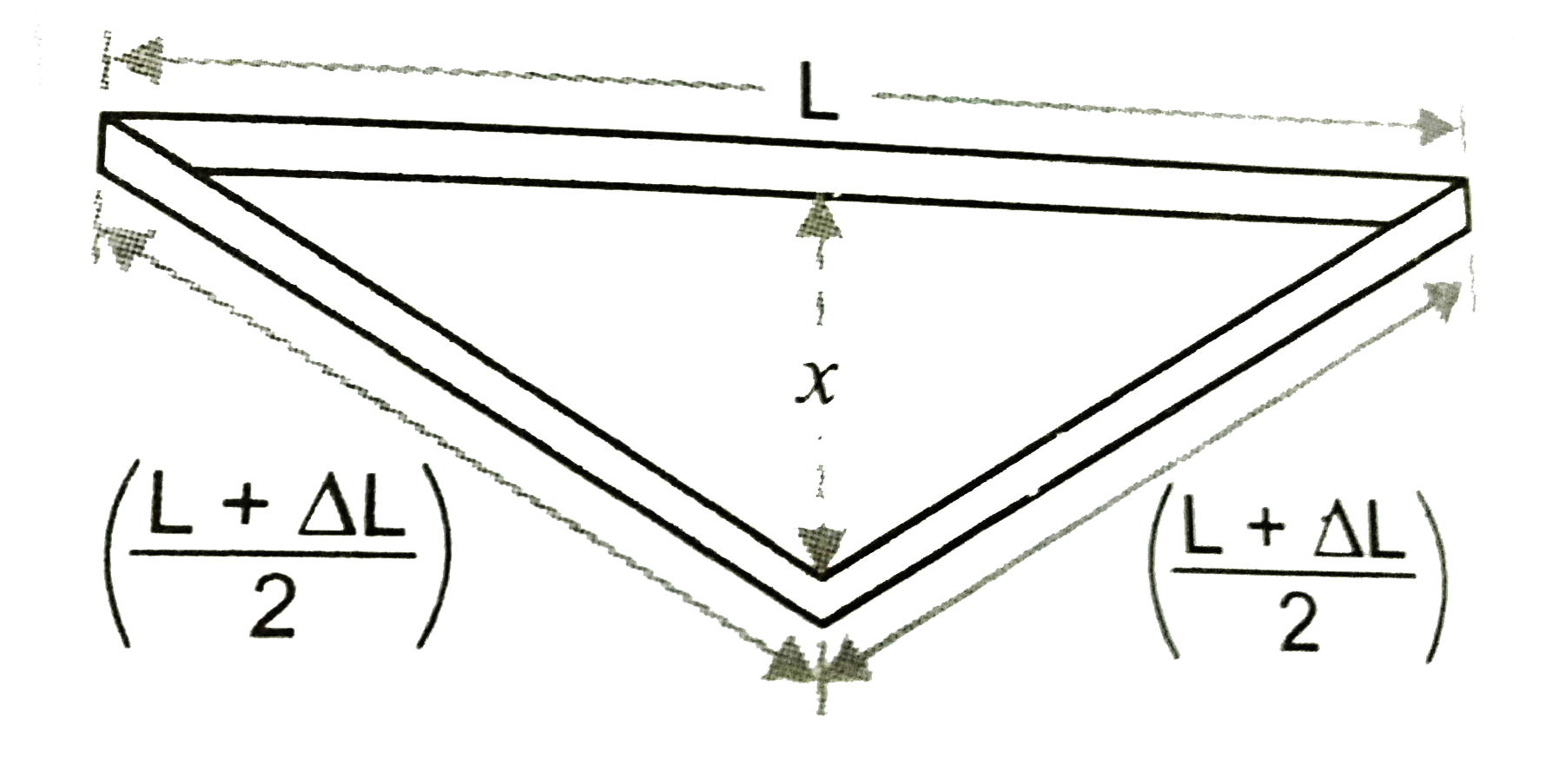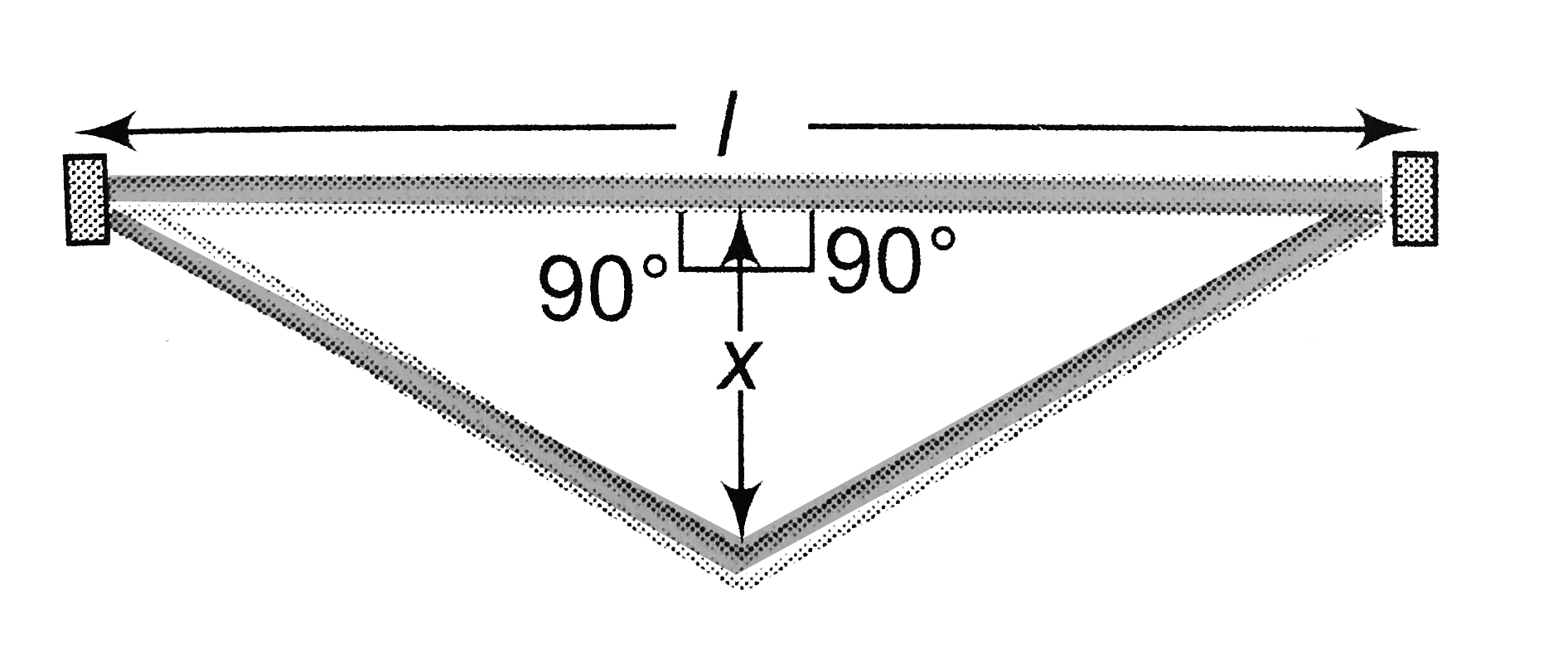A rail track made of steel having length 10 m is clamped on a railway line at its two ends

on a summer day due to rise in temperature by 20∘C, it is deformed as shown in fig. Find x (displacement of the centre) if αsteel=1.2×10−5/∘C.
From the given fing
x=√(L+ΔL2)2−(L2)2=12√(L+ΔL)2−L2=12[ΔL2+2LΔL]1/2 Since ΔL is a small quantity the term wich ΔL2 being very small can be neglected. ∴X=12[2LΔL]1/2
Now ΔL=LαΔθ
x=12[2L×LαΔθ]1/2=102[2×(1.2×10−5)×20]1/2=10[1.2×10−4]1/2
=10×10−2×1.1m≈0.11m
Similar Questions
A rail track made of steel having 20m is clamped on a railway line at its two ends as show in Fig. 7(d).17. On a summer day due to rise in temperature by 22∘C, it is deformed as show in Fig. 7(d).17 .Find displacement of the center (x) . Given cofficient of liner expansion of steel is 1.2×10−5.∘C−1.

View SolutionA steel tape is correctly calibrated at 20∘C and is used to measure the length of a table at 30∘C. Find the percentage error in the measurement of length. [αsteel=11×10−5/.∘C]
View Solution
Knowledge Check
A rail track made of steel having length 10m is clamped on a railway line at its two end (figure). On a summer day due to rise in temperatue by 20∘C. It is deformed as shown in figure. Find x (displacement of the centre) if αsteel=1.2×10−5/∘C
 A15√30×10−3cmB10√30×10−3cmC25√30×10−3cmD20√30×10−3cm
A15√30×10−3cmB10√30×10−3cmC25√30×10−3cmD20√30×10−3cmA steel wire of length 1m and mass 0.1kg and having a uniform cross-sectional area of 10−6m2 is rigidly fixed at both ends. The temperature of the wire is lowered by 20∘C. If the wire is vibrating in fundamental mode, find the frequency (in Hz). (Ysteel=2×1011N/m2,αsteel=1.21×10−5/.∘C).
A11B20C15D10A rod has been laid by using alternate rails of steel and aluminium each 12m long in a winter season when temperature is .−2∘C. The maximum temprature which can must be left be-tween advance rules of they are just to touch on a summer day
(αsteel=1.2×10−5^(0)C−1αAl=2.4×10−5^(0)C−1A0.6cmB1.2cmC0.95cmD0.86cm
The scale on a steel on a steel meter stick is calibrated at 15∘C. What is the error in the reading of 60cm at 27∘C ? αsteel=1.2×10−5(.∘C)−1.
View SolutionA concrete slab has a length of 10 m on a winter night when the temperature is 0C. Find the lenth of the slab on a summer day when the temperature is 35C. The coefficient of linear expansion of concrete is 1.0XX10−50C^(−1).
View SolutionA gasoline tank made of steel is filled completely with 60 litres of gasoline, both at a temperature of 12∘C . How much gasoline will overflow when the temperature is increased to 25∘C ?
αsteel=1.1×10−5∘C−1
γgasoline=9.5×10−4∘C−1
View SolutionA steel rail 30m long is firmly attached to the road be only at its ends. The sun raises the temperature of the rail by 500C, causing the rail to buckle. Assuming that the buckled rail consitst of two straight parts metting in the centre, calculate how much the centre of the rail rise? Given, alpha_(steel) = 12 xx 10^(-6//@)C.
_S01_024_Q01.png)
View SolutionA horizontal steel railroad track has a length of 100 m when the temperature is 25∘C. The track is constrained from expanding or bending. The stress on the strack on a hot summer day, when the temperature is 40∘C, is (Note : the linear coefficient of thermal expansion for steel is 1.1×10−5/.∘C and the Young's modulus of steel is 2×1011 Pa)
View Solution

